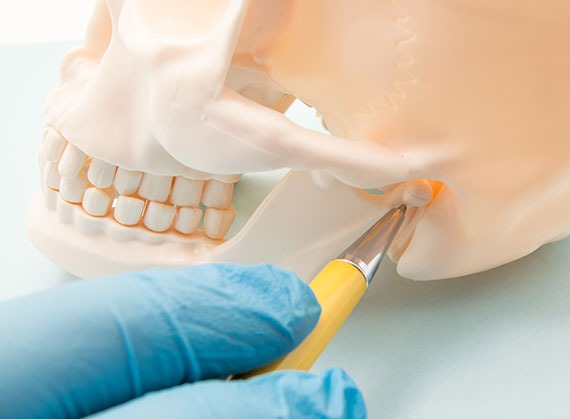Gnathology

What is Gnathology?
Gnathology is the branch of dentistry that studies and treats the masticatory apparatus in all aspects of anatomy and function.
There is a close correlation between the correct contact between the two dental arches, the mandibular muscles and the cranio-mandibular bones, gnathology deals precisely with studying and restoring the correct balance between these districts by solving the resulting symptomatology.
Temporomandibular Joint Disorders (TMD)
The term disorder of the temporomandibular joint (DTM) encompasses a variety of situations involving the masticatory muscles and the temporomandibular joint (ATM), as well as neighboring tissue components. The most frequent symptom associated with TDM is localized pain in the muscles of mastication, in the preauricular area, and / or in the temporomandibular joints (TMJ) and may be due to trauma (to the face), inflammatory or degenerative arthritis or to the fact that the jaw it is pushed out of position when the patient chews or swallows. Sometimes, the muscles of chewing, around the temporomandibular joint can undergo spasm, causing head and neck pain and difficulty in opening the mouth.
Bruxism: symptoms, causes and therapies
Teeth grinding in sleep: how to find out
Very often the sufferer does not know it, at least until he is forced to look for the causes of one or more annoying symptoms that last over time. The most frequent of which is a morning awakening with widespread sensation of pain in the jaws. It can be accompanied by the enlargement of the lymph nodes in the neck, the onset of headaches or migraines during the day, sudden pangs in the temples, tension in the neck, poor digestion and halitosis. Symptoms referable to pathologies that are also very different from one another, but that can be traced, if the specific case is a careful medical-dental analysis, to a phenomenon called bruxism: a widespread disorder characterized by the fact that during night sleep they are digressed teeth or the jaws are tightened for a prolonged time, both in a state of sleep and waking.
The dental examination is decisive: in fact it signals an excessive wear of the teeth (above all the molars and premolars, whose cusps appear worn out) compared to age and due to an improper use of the dental arches, and also a weakening of the teeth themselves, which they become a little mobile and sometimes move away from their home. But although the “bruxist” tends to underestimate the problem, in reality this must be taken into serious consideration, not only to avoid dental problems but because the causes are psychological and concern the whole quality of life. Bruxism expresses, in a form totally involuntary, a strong state of emotional tension that the person holds.
Teeth grinding: the psychosomatic point of view
From a psychosomatic point of view, teeth grinding is an unconscious attempt to discharge a surplus of psychic tension, a share of anxiety or stress that has accumulated during the day and that the subject tends not to express. Emotions are denied and silenced during the day and then reappeared in a more controlled and less dangerous context: sleep.
Treatment of oro-facial pain (facial pain, neck and muscle-tension headache)
Choose the right specialist. The ideal is a gnathologist, a dentist who specializes in chewing problems who will perform one of the following therapies :
- Bite therapy, with corrective (to reposition the arches) and restraining functions (to relax the jaw and neck muscles).
- Physical therapy
- Behavioral therapy
- Pharmacological therapy

